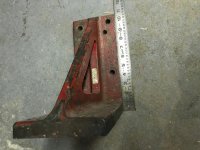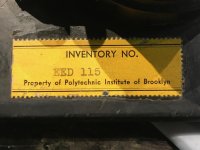I am guessing the old machinist worked for "Oxford Filing", a company in Garden City, LI, who manufactured file folders. Years ago, when I was a HS student, I learned of that firm.
Sperry Gyroscope had quite a history in its own right. It started in a building located in downtown Brooklyn. Sperry was a prolific inventor and built upon his knowledge of gyroscopes to develop automatic pilots (there are old photos of a pilot in a biplane, clearly not handling the controls while the plane flies along on auto pilot). I suspect this early auto pilot maintained a heading, but it was up to the pilot to maintain altitude and attitude of the aircraft. Kind of a two-dimensional auto pilot. Sperry also applied this to marine applications and developed an gyro controlled helm. I do not know when Sperry ceased to exist, but they were quite a firm in their day. Sperry was developing and building some very fine mechanical instrumentation, and an old family friend had been a machinist with them when they were still in Brooklyn.
You came onto your block at the end of a very different generation of people. I was born in 1950 and started working in machine shops in Long Island City (actually a neighborhood in the borough of Queens, inside NY City Limits) when I was a teenager. Back then, the shops were all over the place, and electro-mechanical instrumentation for defense, aviation, and for telecommunications was still in use. Many of the men who worked in those shops were German immigrants as well as some Polish, Swiss, Austrian, and Czech immigrants. It was not uncommon to hear German spoken in the shops in the '60's. The machinists and toolmakers had the wooden Gerstner chests, usually with a kind of grubby patina from oil and coolant mists in the shop's ambient air and the blackened fingers of the owners leaving a darker patina around each drawer pull. In the lids of the top tills, there were family photos, possibly a picture of postcard from their part of "the old country" along with a few handy reference cards for decimal equivalents and similar. Along with the chest came a few coffee cans and cigar boxes filled with things like high speed steel lathe tool bits ground for particular jobs, special cutting tools like end mills ground for a specific job, and similar. Back in those days, smoking in the workplace was a given, and those machinists and toolmakers generally walked around with something in their mouths. Some smoked pipes, many smoked cigars- quite a common thing back then- and some smoke cigarettes. The cigar boxes tell a lot about the man who was the machinist or toolmaker who filled them. I have one box, which had WWII era production tooling in it- from "Marsh-Wheeling Cigars, "still only 5 cents, two for 9 cents".
These guys usually wore white shop aprons, and often had clear plastic tubing for the "strings" on the aprons- the idea being if the apron got wound up in machinery, the plastic tubing would part company before the wearer got wound into things. These guys lived well ordered and simple lives. They rode the subways to work, saved up and bought homes in ethnic residential neighborhoods, put their kids through college and took an occasional trip back to "the old country". They were thrifty, and sometimes brought "government jobs" to the shop, stuff for home like brazing up a kid's busted bicycle frame or repairing some household item.
It was a different time in NYC and its environs, when jobs in the skilled machine trades were common and people in those trades were needed. Firms made medical and dental equipment, and these firms had toolrooms. Other firms made heavier machine products and supported things like the printing industry (NYC was the publishing center of the world back then). Firms like Kollsman Instrument in Queens made aviation instruments. Bulova Watch, also in Queens, was still producing mechanical watch movements and their toolmaker training was said to be top shelf. Alongside the Van Wyck Expressway, in Jamaica, Queens, the Shore Instrument Company was producing the "Scleroscope" hardness testers. There were steel rule die shops producing dies for the garment and shoe industries- both of which were major industries within NYC in those days. There were shops producing stuff for the defense industries. A classmate spent a summer with pillar files, putting chamfers on buckles for parachute harnesses that the shop he worked in was stamping out, having made the dies for the job. He was told that if the corners on the buckles were not properly chamfered, the shock on the harness when the 'chute opened could part the harness and cost the user his life. So, my classmate spent that summer deburring and chamfering buckle stampings. This was in a back alley shop run by a couple of recent immigrants who had a few machine tools and a couple of bloodthirsty punch presses.
It was also a very different time in NYC and its environs because people working in the skilled machine trades could afford to buy their own homes and live nicely. Often, some of these same toolmakers or machinists would get a Bridgeport, a lathe and a surface grinder of their own and take on work in their basements or garages- aside from the regular job in the shop. It was quite common. The fellow whose lathe you have gotten exemplified the breed and era I am trying to depict here.
As I've written, this is going back about 50 years, and it's a way of life and breed of people that are all long gone from NYC's 5 boroughs as well as Long Island.
Now, if a person does work in the skilled machine or metal fabrication trades, they usually cannot afford to live near where they work if it is within the 5 boroughs.
The area where the old shops were, in Long Island City, has been "yuppified" or "gentrified". Back when I was a teenager, you could walk down most blocks of Long Island City and find shops ranging from two or three men in a small tool and die shop to good sized shops. Supply houses also were located there, and Travers Tool started there as a small family operation. Now, there is not a machine shop or supply house to be found in that area, and the word is Amazon is coming in with some kind of regional headquarters. The industrial space is going for "loft housing" or businesses like trendy coffee shops and eateries or art galleries.
The oldtimer whose Clausing lathe you have gotten was of that old breed. Thrifty, highly skilled, living quietly and within his means and able to buy his own home.
Look around the stuff you got from his basement and see if you don't find coffee cans, biscuit or candy tins, and cigar boxes which contain tool bits, end mills, taps, dies, and odd parts from past jobs. You can get a sense of the man by that sort of thing. These were not men who smoked fancy Cuban cigars, and more likely White Owls or similar. Notes on stuff left by the oldtimer will also tell a lot. European handwriting is pretty easy to spot. As I said, these men were of a different era and are just about extinct. I was fortunate to "come up" in shops where they were foremen and journeymen.
BTW: My own shop abounds in 3 liter olive oil tins, used to hold a variety of stuff. I suppose someone poking through my shop when I am passed from this life will look at the loads of olive oil tins and my calligraphy with the paint markers and wonder who the hell the guy was who accumulated all that stuff. I imagine they might be saying something like: "Holy ----, this guy and his family LIVED on olive oil... what'd he do ? Lube his machine tools and fill his car's crankcase with the stuff ?"
I did get in the habit of taking a fine tip paint marker and lettering the "provenance" on my machine tools and equipment such as: "Purchased 20 October, 1985 from Grand Machinery, NYC" or "Purchased November 2012 from estate of 2nd owner ------, original owner: Ertel Engineering, Kingston, NY, shipped 26 July, 1943". I figure someday people such as those of us who participate in this 'board may come into my shop to clear it out and be asking the kinds of questions many of us ask: "Who was this guy and where did he get this lathe (or mill, or grinder, etc)"




















